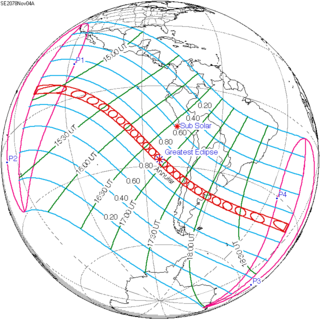| Solar eclipse of November 4, 2078 | |
|---|---|
| Type of eclipse | |
| Nature | Annular |
| Gamma | −0.2285 |
| Magnitude | 0.9255 |
| Maximum eclipse | |
| Duration | 509 s (8 min 29 s) |
| Coordinates | 27°48′S 83°18′W / 27.8°S 83.3°W |
| Max. width of band | 287 km (178 mi) |
| Times (UTC) | |
| Greatest eclipse | 16:55:44 |
| References | |
| Saros | 144 (20 of 70) |
| Catalog # (SE5000) | 9684 |
An annular solar eclipse will occur at the Moon's descending node of orbit on Friday, November 4, 2078,[1] with a magnitude of 0.9255. A solar eclipse occurs when the Moon passes between Earth and the Sun, thereby totally or partly obscuring the image of the Sun for a viewer on Earth. An annular solar eclipse occurs when the Moon's apparent diameter is smaller than the Sun's, blocking most of the Sun's light and causing the Sun to look like an annulus (ring). An annular eclipse appears as a partial eclipse over a region of the Earth thousands of kilometres wide. Occurring only about 22 hours before apogee (on November 5, 2078, at 14:45 UTC), the Moon's apparent diameter will be smaller.[2]
The path of annularity will be visible from parts of Chile, Argentina, and Tristan da Cunha. A partial solar eclipse will also be visible for parts of eastern Oceania, Mexico, the southwestern United States, Central America, South America, and Antarctica.
- ^ "November 4, 2078 Annular Solar Eclipse". timeanddate. Retrieved 22 August 2024.
- ^ "Moon Distances for London, United Kingdom, England". timeanddate. Retrieved 22 August 2024.
